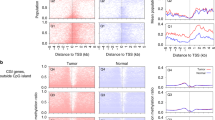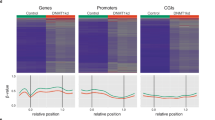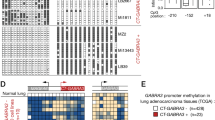Abstract
The tumor suppressor gene hypermethylated in cancer 1 (HIC1), located on human chromosome 17p13.3, is frequently silenced in cancer by epigenetic mechanisms. Hypermethylated in cancer 1 belongs to the bric à brac/poxviruses and zinc-finger family of transcription factors and acts by repressing target gene expression. It has been shown that enforced p53 expression leads to increased HIC1 mRNA, and recent data suggest that p53 and Hic1 cooperate in tumorigenesis. In order to elucidate the regulation of HIC1 expression, we have analysed the HIC1 promoter region for p53-dependent induction of gene expression. Using progressively truncated luciferase reporter gene constructs, we have identified a p53-responsive element (PRE) 500 bp upstream of the TATA-box containing promoter P0 of HIC1, which is sequence specifically bound by p53 in vitro as assessed by electrophoretic mobility shift assays. We demonstrate that this HIC1 p53-responsive element (HIC1.PRE) is necessary and sufficient to mediate induction of transcription by p53. This result is supported by the observation that abolishing endogenous wild-type p53 function prevents HIC1 mRNA induction in response to UV-induced DNA damage. Other members of the p53 family, notably TAp73β and ΔNp63α, can also act through this HIC1.PRE to induce transcription of HIC1, and finally, hypermethylation of the HIC1 promoter attenuates inducibility by p53.
This is a preview of subscription content, access via your institution
Access options
Subscribe to this journal
Receive 50 print issues and online access
$259.00 per year
only $5.18 per issue
Buy this article
- Purchase on Springer Link
- Instant access to full article PDF
Prices may be subject to local taxes which are calculated during checkout







Similar content being viewed by others
References
Ahuja N, Mohan AL, Li Q, Stolker JM, Herman JG, Hamilton SR et al. (1997). Cancer Res 57: 3370–3374.
Arnold CN, Goel A, Boland CR . (2003). Int J Cancer 106: 66–73.
Bahia H, Ashman JN, Cawkwell L, Lind M, Monson JR, Drew PJ et al. (2002). Int J Oncol 20: 489–494.
Beillard E, Pallisgaard N, van der Velden VH, Bi W, Dee R, van der Schoot E et al. (2003). Leukemia 17: 2474–2486.
Benard J, Douc-Rasy S, Ahomadegbe JC . (2003). Hum Mutat 21: 182–191.
Bunz F, Dutriaux A, Lengauer C, Waldman T, Zhou S, Brown JP et al. (1998). Science 282: 1497–1501.
Chen W, Cooper TK, Zahnow CA, Overholtzer M, Zhao Z, Ladanyi M et al. (2004). Cancer Cell 6: 387–398.
Chen W, Wang DH, Yen RC, Luo J, Gu W, Baylin SB . (2005). Proc Am Assoc Cancer Res 46 (abstract LB-116): 114.
Chen WY, Zeng X, Carter MG, Morrell CN, Chiu Yen RW, Esteller M et al. (2003). Nat Genet 33: 197–202.
Deltour S, Guerardel C, Leprince D . (1999). Proc Natl Acad Sci USA 96: 14831–14836.
Di Como CJ, Gaiddon C, Prives C . (1999). Mol Cell Biol 19: 1438–1449.
el-Deiry WS, Kern SE, Pietenpol JA, Kinzler KW, Vogelstein B . (1992). Nat Genet 1: 45–49.
Fontemaggi G, Kela I, Amariglio N, Rechavi G, Krishnamurthy J, Strano S et al. (2002). J Biol Chem 277: 43359–43368.
Fujii H, Biel MA, Zhou W, Weitzman SA, Baylin SB, Gabrielson E . (1998). Oncogene 16: 2159–2164.
Galimi F, Noll M, Kanazawa Y, Lax T, Chen C, Grompe M et al. (2002). Blood 100: 2732–2736.
Grob TJ, Novak U, Maisse C, Barcaroli D, Luthi AU, Pirnia F et al. (2001). Cell Death Differ 8: 1213–1223.
Guerardel C, Deltour S, Pinte S, Monte D, Begue A, Godwin AK et al. (2001). J Biol Chem 276: 3078–3089.
Issa JP, Zehnbauer BA, Kaufmann SH, Biel MA, Baylin SB . (1997). Cancer Res 57: 1678–1681.
Jones PA, Baylin SB . (2002). Nat Rev Genet 3: 415–428.
Liu G, Nozell S, Xiao H, Chen X . (2004a). Mol Cell Biol 24: 487–501.
Liu X, Yue P, Khuri FR, Sun SY . (2004b). Cancer Res 64: 5078–5083.
Livak KJ, Schmittgen TD . (2001). Methods 25: 402–408.
Luo J, Nikolaev AY, Imai S, Chen D, Su F, Shiloh A et al. (2001). Cell 107: 137–148.
Marchuk D, Drumm M, Saulino A, Collins FS . (1991). Nucleic Acids Res 19: 1154.
Marin MC, Jost CA, Irwin MS, DeCaprio JA, Caput D, Kaelin Jr WG . (1998). Mol Cell Biol 18: 6316–6324.
Melino G, De Laurenzi V, Vousden KH . (2002). Nat Rev Cancer 2: 605–615.
Moll UM, Slade N . (2004). Mol Cancer Res 2: 371–386.
Nakano K, Vousden KH . (2001). Mol Cell 7: 683–694.
Nemoto S, Fergusson MM, Finkel T . (2004). Science 306: 2105–2108.
Nicoll G, Crichton DN, McDowell HE, Kernohan N, Hupp TR, Thompson AM . (2001). Br J Cancer 85: 1878–1882.
Obad S, Brunnstrom H, Vallon-Christersson J, Borg A, Drott K, Gullberg U . (2004). Oncogene 23: 4050–4059.
Pinte S, Guerardel C, Deltour-Balerdi S, Godwin AK, Leprince D . (2004a). Oncogene 23: 4023–4031.
Pinte S, Stankovic-Valentin N, Deltour S, Rood BR, Guerardel C, Leprince D . (2004b). J Biol Chem 279: 38313–38324.
Qian H, Wang T, Naumovski L, Lopez CD, Brachmann RK . (2002). Oncogene 21: 7901–7911.
Ruiz de Almodovar C, Ruiz-Ruiz C, Rodriguez A, Ortiz-Ferron G, Redondo JM, Lopez-Rivas A . (2004). J Biol Chem 279: 4093–4101.
Sun P, Dong P, Dai K, Hannon GJ, Beach D . (1998). Science 282: 2270–2272.
Tschan MP, Fischer KM, Fung VS, Pirnia F, Borner MM, Fey MF et al. (2003). J Biol Chem 278: 42750–42760.
Vaziri H, Dessain SK, Ng Eaton E, Imai SI, Frye RA, Pandita TK et al. (2001). Cell 107: 149–159.
Voorhoeve PM, Agami R . (2003). Cancer Cell 4: 311–319.
Wales MM, Biel MA, el Deiry W, Nelkin BD, Issa JP, Cavenee WK et al. (1995). Nat Med 1: 570–577.
Wolcke J, Reimann M, Klumpp M, Gohler T, Kim E, Deppert W . (2003). J Biol Chem 278: 32587–32595.
Wu G, Osada M, Guo Z, Fomenkov A, Begum S, Zhao M et al. (2005). Cancer Res 65: 758–766.
Acknowledgements
We thank Dr D Leprince (Institut Pasteur de Lille, Lille, France) and Dr R Iggo (Swiss Institute for Experimental Cancer Research, Epalinges, Switzerland) for helpful discussions; Dr B Vogelstein (The Sidney Kimmel Comprehensive Cancer Center and The Howard Hughes Medical Institute, The Johns Hopkins University Medical Institutions, Baltimore, MA) for providing HCT116 p53−/−; and Dr R Agami (The Netherlands Cancer Institute, Amsterdam, The Netherlands), Dr G Melino (MRC, Toxicology Unit, Leicester, UK) and Dr P Sun (The Scripps Research Institute, La Jolla, CA) for providing plasmid constructs. This work was supported by Grants SNF 3100-067213, the Bernese Cancer League, the Werner and Hedy Berger-Janser Stiftung for Cancer Research to MFF and AT, Grant NIH AI49165 to BET and Grant OCS 01510-02-2004 of the Swiss Cancer League to ACA. MPT is recipient of a Swiss Federation against Cancer fellowship (No. BIL OCS-01198-09-2001).
Author information
Authors and Affiliations
Corresponding author
Rights and permissions
About this article
Cite this article
Britschgi, C., Rizzi, M., Grob, T. et al. Identification of the p53 family-responsive element in the promoter region of the tumor suppressor gene hypermethylated in cancer 1. Oncogene 25, 2030–2039 (2006). https://doi.org/10.1038/sj.onc.1209240
Received:
Revised:
Accepted:
Published:
Issue Date:
DOI: https://doi.org/10.1038/sj.onc.1209240
Keywords
This article is cited by
-
Hexokinase 3 enhances myeloid cell survival via non-glycolytic functions
Cell Death & Disease (2022)
-
The autophagy scaffold protein ALFY is critical for the granulocytic differentiation of AML cells
Scientific Reports (2017)
-
WIPI-dependent autophagy during neutrophil differentiation of NB4 acute promyelocytic leukemia cells
Cell Death & Disease (2014)
-
BIRC6 (APOLLON) is down-regulated in acute myeloid leukemia and its knockdown attenuates neutrophil differentiation
Experimental Hematology & Oncology (2012)
-
Signification of Hypermethylated in Cancer 1 (HIC1) as Tumor Suppressor Gene in Tumor Progression
Cancer Microenvironment (2012)



